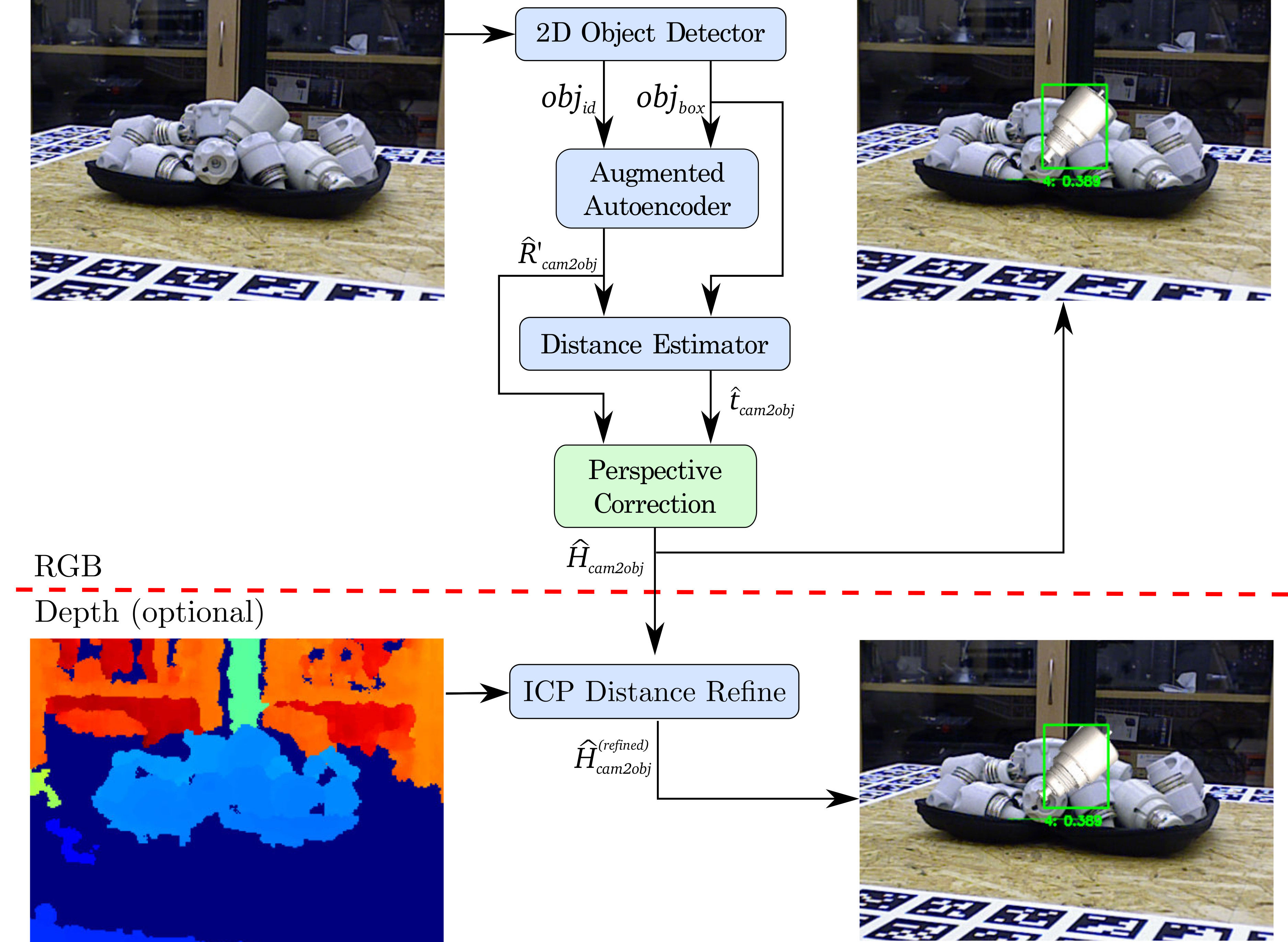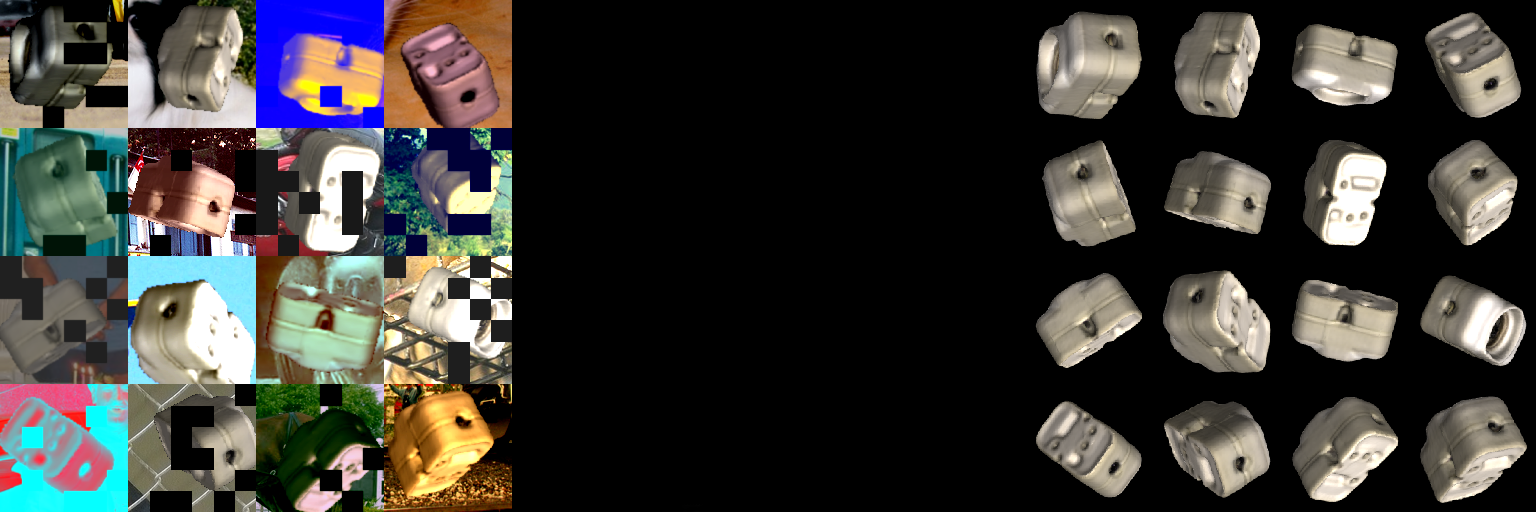This is the modified version of the original repository https://github.com/DLR-RM/AugmentedAutoencoder.
Martin Sundermeyer, Zoltan-Csaba Marton, Maximilian Durner, Manuel Brucker, Rudolph Triebel
Best Paper Award, ECCV 2018.
If you find Augmented Autoencoders useful for your research, please consider citing:
@InProceedings{Sundermeyer_2018_ECCV,
author = {Sundermeyer, Martin and Marton, Zoltan-Csaba and Durner, Maximilian and Brucker, Manuel and Triebel, Rudolph},
title = {Implicit 3D Orientation Learning for 6D Object Detection from RGB Images},
booktitle = {The European Conference on Computer Vision (ECCV)},
month = {September},
year = {2018}
}
We propose a real-time RGB-based pipeline for object detection and 6D pose estimation. Our novel 3D orientation estimation is based on a variant of the Denoising Autoencoder that is trained on simulated views of a 3D model using Domain Randomization. This so-called Augmented Autoencoder has several advantages over existing methods: It does not require real, pose-annotated training data, generalizes to various test sensors and inherently handles object and view symmetries.
1.) Train the Augmented Autoencoder(s) using only a 3D model to predict 3D Object Orientations from RGB image crops
2.) For full RGB-based 6D pose estimation, also train a 2D Object Detector (e.g. https://github.com/fizyr/keras-retinanet)
3.) Optionally, use our standard depth-based ICP to refine the 6D Pose
Nvidia GPU with >4GB memory (or adjust the batch size)
RAM >8GB
Duration depending on Configuration and Hardware: ~3h per Object
Linux, Python 2.7 / Python 3 (experimental)
GLFW for OpenGL:
sudo apt-get install libglfw3-dev libglfw3 Assimp:
sudo apt-get install libassimp-dev Tensorflow >= 1.6
OpenCV >= 3.1
pip install --user --pre --upgrade PyOpenGL PyOpenGL_accelerate
pip install --user cython
pip install --user cyglfw3
pip install --user pyassimp==3.3
pip install --user imgaug
pip install --user progressbarPlease note that we use the GLFW context as default which does not support headless rendering. To allow for both, onscreen rendering & headless rendering on a remote server, set the context to EGL:
export PYOPENGL_PLATFORM='egl'
In order to make the EGL context work, you might need to change PyOpenGL like here
1. Pip installation
pip install --user .2. Set Workspace path, consider to put this into your bash profile, will always be required
export AE_WORKSPACE_PATH=/path/to/autoencoder_ws 3. Create Workspace, Init Workspace (if installed locally, make sure .local/bin/ is in your PATH)
mkdir $AE_WORKSPACE_PATH
cd $AE_WORKSPACE_PATH
ae_init_workspace1. Create the training config file. Insert the paths to your 3D model and background images.
mkdir $AE_WORKSPACE_PATH/cfg/exp_group
cp $AE_WORKSPACE_PATH/cfg/train_template.cfg $AE_WORKSPACE_PATH/cfg/exp_group/my_autoencoder.cfg
gedit $AE_WORKSPACE_PATH/cfg/exp_group/my_autoencoder.cfg2. Generate and check training data. The object views should be strongly augmented but identifiable.
(Press ESC to close the window.)
ae_train exp_group/my_autoencoder -dThis command does not start training and should be run on a PC with a display connected.
3. Train the model (See the Headless Rendering section if you want to train directly on a server without display)
ae_train exp_group/my_autoencoder$AE_WORKSPACE_PATH/experiments/exp_group/my_autoencoder/train_figures/training_images_29999.png Middle part should show reconstructions of the input object (if all black, set higher bootstrap_ratio / auxilliary_mask in training config)
4. Create the embedding
ae_embed exp_group/my_autoencoderhave a look at /auto_pose/test/
Feed one or more object crops from disk into AAE and predict 3D Orientation
python aae_image.py exp_group/my_autoencoder -f /path/to/image/file/or/folderThe same with a webcam input stream
python aae_webcam.py exp_group/my_autoencoderOption 1: Train a RetinaNet Model from https://github.com/fizyr/keras-retinanet
adapt $AE_WORKSPACE_PATH/eval_cfg/aae_retina_webcam.cfg
python auto_pose/test/aae_retina_webcam_pose.py -test_config aae_retina_webcam.cfg -visOption 2: Using the Google Detection API with Fixes
Train a 2D detector following https://github.com/naisy/train_ssd_mobilenet
adapt /auto_pose/test/googledet_utils/googledet_config.yml
python auto_pose/test/aae_googledet_webcam_multi.py exp_group/my_autoencoder exp_group/my_autoencoder2 exp_group/my_autoencoder3For the evaluation you will also need https://github.com/thodan/sixd_toolkit + our extensions, see sixd_toolkit_extension/help.txt
Create the evaluation config file
mkdir $AE_WORKSPACE_PATH/cfg_eval/eval_group
cp $AE_WORKSPACE_PATH/cfg_eval/eval_template.cfg $AE_WORKSPACE_PATH/cfg_eval/eval_group/eval_my_autoencoder.cfg
gedit $AE_WORKSPACE_PATH/cfg_eval/eval_group/eval_my_autoencoder.cfgSet estimate_bbs=False in the evaluation config
ae_eval exp_group/my_autoencoder name_of_evaluation --eval_cfg eval_group/eval_my_autoencoder.cfg
e.g.
ae_eval tless_nobn/obj5 eval_name --eval_cfg tless/5.cfgSet estimate_bbs=True in the evaluation config
Generate a training dataset for T-Less using detection_utils/generate_sixd_train.py
python detection_utils/generate_sixd_train.pyTrain https://github.com/fizyr/keras-retinanet or https://github.com/balancap/SSD-Tensorflow
ae_eval exp_group/my_autoencoder name_of_evaluation --eval_cfg eval_group/eval_my_autoencoder.cfg
e.g.
ae_eval tless_nobn/obj5 eval_name --eval_cfg tless/5.cfg[Paths]
# Path to the model file. All formats supported by assimp should work. Tested with ply files.
MODEL_PATH: /path/to/my_3d_model.ply
# Path to some background image folder. Should contain a * as a placeholder for the image name.
BACKGROUND_IMAGES_GLOB: /path/to/VOCdevkit/VOC2012/JPEGImages/*.jpg
[Dataset]
#cad or reconst (with texture)
MODEL: reconst
# Height of the AE input layer
H: 128
# Width of the AE input layer
W: 128
# Channels of the AE input layer (default BGR)
C: 3
# Distance from Camera to the object in mm for synthetic training images
RADIUS: 700
# Dimensions of the renderered image, it will be cropped and rescaled to H, W later.
RENDER_DIMS: (720, 540)
# Camera matrix used for rendering and optionally for estimating depth from RGB
K: [1075.65, 0, 720/2, 0, 1073.90, 540/2, 0, 0, 1]
# Vertex scale. Vertices need to be scaled to mm
VERTEX_SCALE: 1
# Antialiasing factor used for rendering
ANTIALIASING: 8
# Padding rendered object images and potentially bounding box detections
PAD_FACTOR: 1.2
# Near plane
CLIP_NEAR: 10
# Far plane
CLIP_FAR: 10000
# Number of training images rendered uniformly at random from SO(3)
NOOF_TRAINING_IMGS: 10000
# Number of background images that simulate clutter
NOOF_BG_IMGS: 10000
[Augmentation]
# Using real object masks for occlusion (not really necessary)
REALISTIC_OCCLUSION: False
# Maximum relative translational offset of input views, sampled uniformly
MAX_REL_OFFSET: 0.20
# Random augmentations at random strengths from imgaug library
CODE: Sequential([
#Sometimes(0.5, PerspectiveTransform(0.05)),
#Sometimes(0.5, CropAndPad(percent=(-0.05, 0.1))),
Sometimes(0.5, Affine(scale=(1.0, 1.2))),
Sometimes(0.5, CoarseDropout( p=0.2, size_percent=0.05) ),
Sometimes(0.5, GaussianBlur(1.2*np.random.rand())),
Sometimes(0.5, Add((-25, 25), per_channel=0.3)),
Sometimes(0.3, Invert(0.2, per_channel=True)),
Sometimes(0.5, Multiply((0.6, 1.4), per_channel=0.5)),
Sometimes(0.5, Multiply((0.6, 1.4))),
Sometimes(0.5, ContrastNormalization((0.5, 2.2), per_channel=0.3))
], random_order=False)
[Embedding]
# for every rotation save rendered bounding box diagonal for projective distance estimation
EMBED_BB: True
# minimum number of equidistant views rendered from a view-sphere
MIN_N_VIEWS: 2562
# for each view generate a number of in-plane rotations to cover full SO(3)
NUM_CYCLO: 36
[Network]
# additionally reconstruct segmentation mask, helps when AAE decodes pure blackness
AUXILIARY_MASK: False
# Variational Autoencoder, factor in front of KL-Divergence loss
VARIATIONAL: 0
# Reconstruction error metric
LOSS: L2
# Only evaluate 1/BOOTSTRAP_RATIO of the pixels with highest errors, produces sharper edges
BOOTSTRAP_RATIO: 4
# regularize norm of latent variables
NORM_REGULARIZE: 0
# size of the latent space
LATENT_SPACE_SIZE: 128
# number of filters in every Conv layer (decoder mirrored)
NUM_FILTER: [128, 256, 512, 512]
# stride for encoder layers, nearest neighbor upsampling for decoder layers
STRIDES: [2, 2, 2, 2]
# filter size encoder
KERNEL_SIZE_ENCODER: 5
# filter size decoder
KERNEL_SIZE_DECODER: 5
[Training]
OPTIMIZER: Adam
NUM_ITER: 30000
BATCH_SIZE: 64
LEARNING_RATE: 1e-4
SAVE_INTERVAL: 5000
[Queue]
# number of threads for producing augmented training data (online)
NUM_THREADS: 10
# preprocessing queue size in number of batches
QUEUE_SIZE: 50
